Alibaba Statistics And Facts (2025)
Updated · Sep 24, 2025

Table of Contents
- Introduction
- Editor’s Choice
- Key Facts
- Alibaba Revenue
- Alibaba Group Consolidated Revenue
- Alibaba Annual E-commerce Revenue
- Alibaba Employees
- Alibaba’s Annual Segment Revenue Distribution
- Alibaba’s Financial Performance in Q4 2024
- Alibaba Traffic By Country
- Alibaba User By Age
- Factors Influencing Alibaba’s Growth And Challenges
- Conclusion
Introduction
Alibaba Statistics: Alibaba Group Holding Limited, the entity that began life in 1999, has come a long way since it was founded by Jack Ma, now developing into a global conglomerate covering everything from e-commerce through cloud computing to digital media and more. This paper presents the current Alibaba statistics for the year in question, with key metrics and trends.
Editor’s Choice
- According to Alibaba statistics, Alibaba Cloud generated worldwide revenues of US$3545 million in the 2023 fiscal year, covering services such as storage, content delivery networks, relational databases, and cybersecurity.
- Alibaba’s total revenue for Q4 2024 amounted to approximately 280.2 billion yuan, driven primarily by core commerce, cloud computing, and digital media.
- For the year ending March 31, 2024, Alibaba posted an e-commerce revenue of 434.9 billion yuan (US$60.2 billion) in China alone, with total revenue at 941 billion yuan (US$130.4 billion).
- In March 2024, there were about 204,891 full-time employees at Alibaba, thus making it one of China’s largest publicly listed internet companies.
- Alibaba statistics state that domestic e-commerce covered 41% of the revenue of Alibaba, over 414 billion yuan, while international e-commerce contributed only 8% but was recording an increase of 60% in 2024.
- Net income attributable to ordinary shareholders in Q4 2024 was RMB 48,945 million (US$ 6,705 million) compared with an increase of 333 % year on year.
- Free cash flow was reduced by 31% to RMB 39,020 million (US$ 5,346 million), overwhelmingly due to rising investments in cloud infrastructure.
- Alibaba statistics show that the United States accounted for 17.73% of the website traffic for Alibaba, followed by China at 12.39%, with other countries making up 59.72%.
- The largest age group among Alibaba users is actually from 25 to 34 years old (28.52%), with the second group being 35 to 44 years old (19.95%) and finally 18 to 24 years with 19.35%, while older demographics have a much lower engagement.
- Alibaba is enjoying growth from its investments in AI, global expansion, and the sales record of Singles Day, but hurdles include slowdowns in economic activity, intense competition, regulatory scrutiny, and soaring operational costs.
- The company is pursuing AI-enabled cloud and global partnerships as its primary strategy for sustaining long-term growth, even as it battles pressure from heavy competitors such as JD.com, Pinduoduo, and Amazon.
- Alibaba statistics state that regarding AI and cloud businesses, the company is viewed positively, causing share prices to rise by more than 13% in 2024 but slightly dipping in the wake of disappointing revenue figures in its latest earnings report.
Key Facts
- Alibaba’s versatile nature allows it to focus on various dimensions such as B2B, B2C, and C2C e-commerce, cloud computing, local services, logistics, and financial services.
- The online retail markets of Alibaba contributed almost 25% towards the total global e-commerce market during the year 2022, which is almost twice as much as Amazon.
- The intense competition given by the social commerce companies and the rigorous monopoly regulations of China have impacted the business performance of Alibaba.
- Alibaba statistics show that by 2023, Alibaba’s market valuation fell to US$216.6 billion, which is 80% less than its peak.
- The late 1990s saw a surge in the Internet industry of China and inspired many entrepreneurs, one such being Jack Ma, an English teacher who created Alibaba as a place for B2B trade.
- Success came to Alibaba with the unveiling of Taobao in 2003 (C2C) followed by Tmall in 2008 (B2C)- filling enormous online retail voids in the country.
- Instead of focusing just on e-commerce, it had launched Alipay (third-party payment), Aliwangwang (instant messaging), and Alimama (digital marketing).
- By the fiscal year ending March 31, 2023, Alibaba’s revenue exceeded 860 billion yuan for the annual period, growing more than 16 times in the last ten years.
- Alibaba accounted for over 300 million international consumers, boosting its growth in various sectors like cloud computing, logistics, O2O services, and entertainment.
- In 2014, the company spun off Alipay into Ant Group, thereby strengthening its financial services business.
- Domestic e-commerce remains the biggest source of revenue for Alibaba, although other business segments have attained considerable growth.
- Rising competition within social and short-video commerce entails Pinduoduo, Douyin, and Kuaishou, whose innovations have been seen as competitive threats to Alibaba’s market.
- In 2021, the customer acquisition cost of Alibaba had reached 477 yuan, almost six times the one incurred by Kuaishou.
- Alibaba statistics state that the company has met growing skepticism internationally, with 16% of U.S. adults in favor of a ban on the company.
- A survey in Peru placed Alibaba among the lowest-ranked companies in trust regarding data privacy.
- Among the local challenges are unpredictability in China’s policies and the countries’ crackdowns on regulation, together affecting investor confidence.
- On November 3, 2020, it scrapped a planned US$34.5 billion IPO by Ant Group; it would have been the world’s largest.
- In the months that followed the suspension of IPOs, Alibaba and other tech behemoths found themselves under investigation by Chinese regulators for anti-monopoly violations.
- Alibaba was fined US$2.8 billion as a result of the antitrust investigation, marking one of the highest penalties imposed on a tech company in China.
Alibaba Revenue
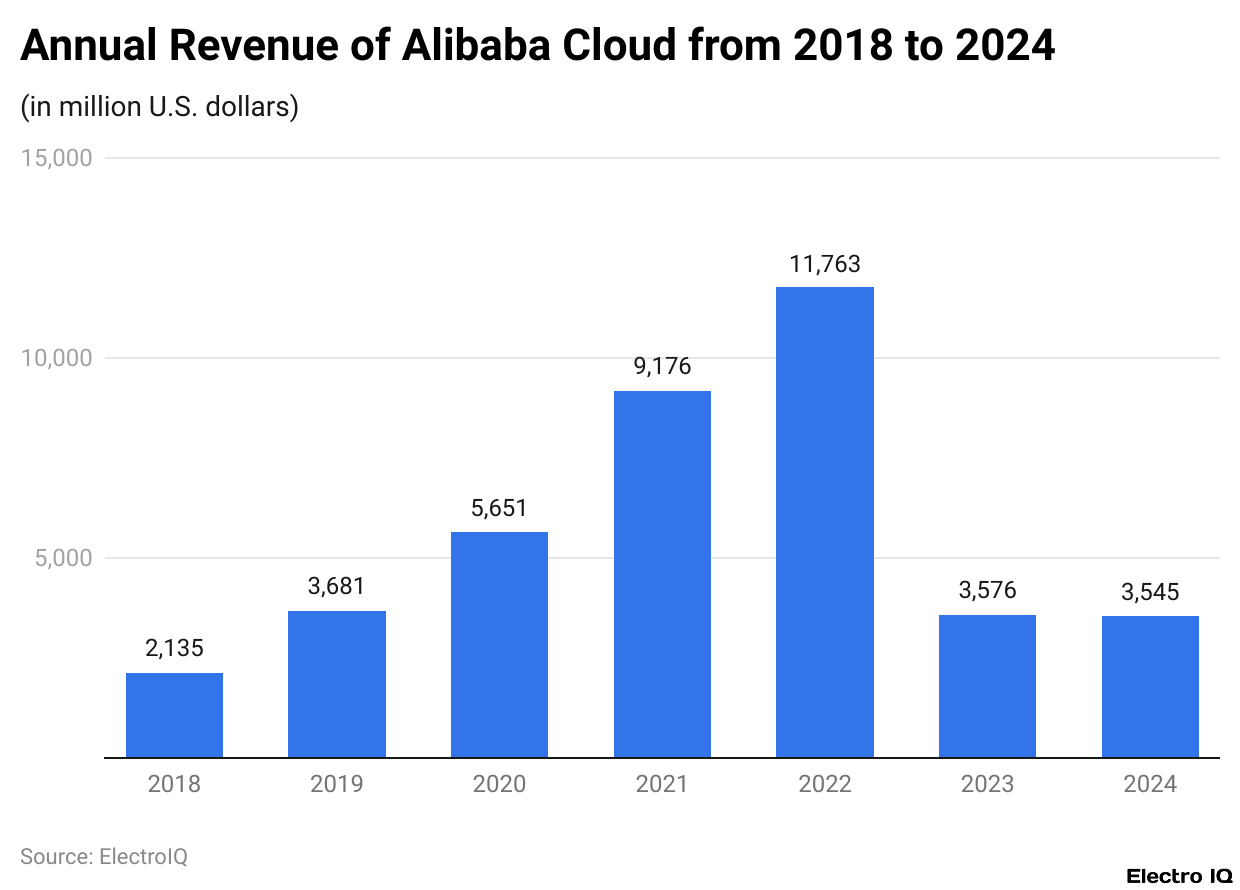
(Reference: statista.com)
- Alibaba, known as Alyiun, is a subsidiary of Alibaba Group and aloft Chinese cloud computing firm. It had a lunar revenue of US$3,545 million in the fiscal year 2023.
- Cloud computing services are provided by Alibaba Cloud: for data storage, CDN, relational databases, anti-DDoS protection, and so on.
Alibaba Group Consolidated Revenue
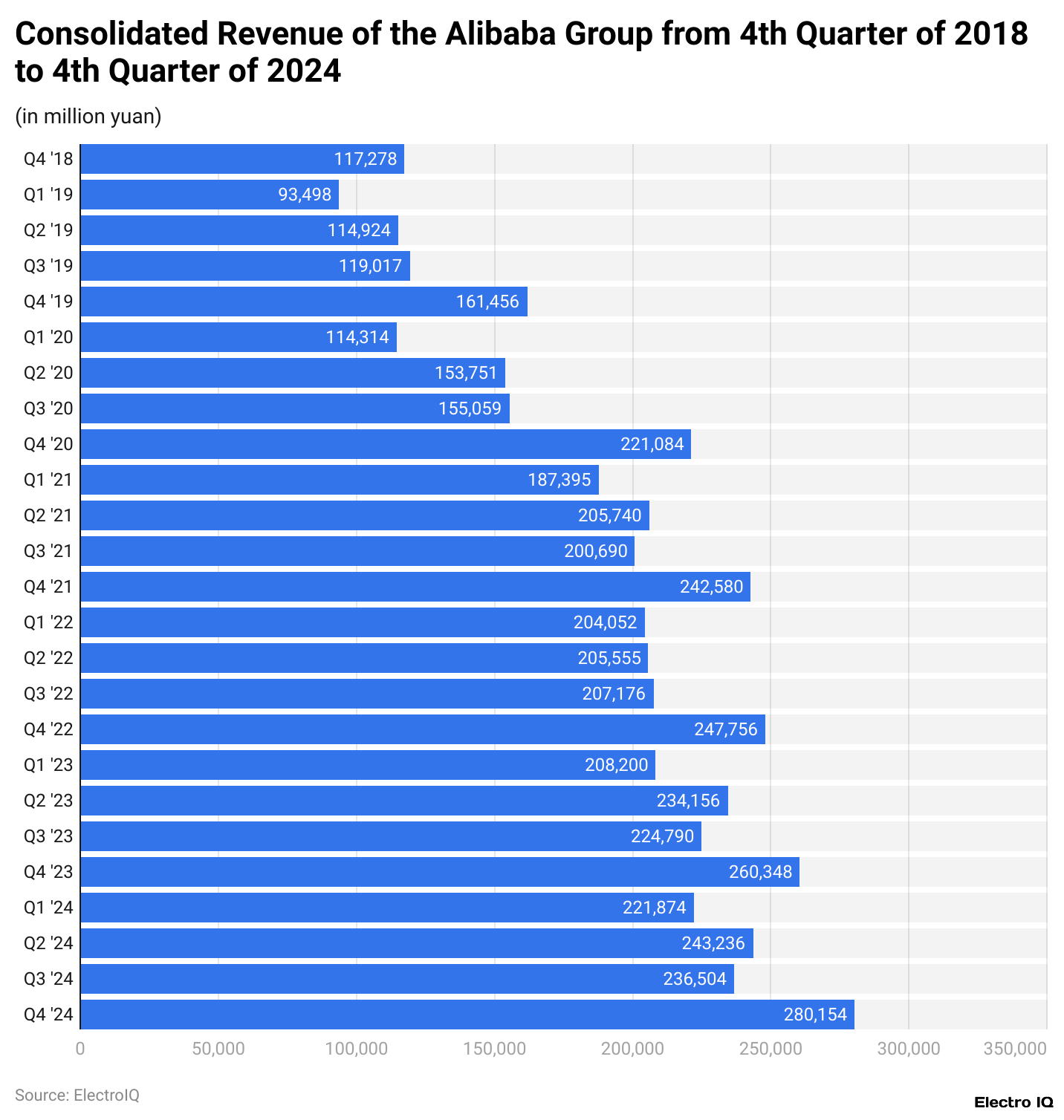
(Reference: statista.com)
- According to Alibaba statistics, in the fourth quarter of 2024, Alibaba had approximately 280.2 billion yuan in revenue. The company organises its operations into a number of business segments.
- Core commerce is the prime revenue earner for them; this includes such platforms as Taobao and Tmall. Cloud computing is another important segment providing enterprise solutions and AI-driven services.
- Digital media and entertainment furnish the company with revenues from online streaming, gaming, and content production.
- Initiatives in innovation and other businesses focus on new technologies and new ventures in support of Alibaba’s long-term growth plans.
Alibaba Annual E-commerce Revenue

(Reference: statista.com)
- Alibaba statistics show that in the FY 2023 fee ending March 31, 2024, Alibaba Group generated revenue of 434.9 billion yuan (US$60.2 billion) from online sales in China.
- For this year, the group’s revenue amounted was 941 billion yuan (US$130.4 billion). The gross merchandise volume of the Chinese e-commerce market is estimated at around 15.4 trillion yuan in 2023, and the growth is on its way.
- Some factors contributing to this development are expanding internet penetration, an increase in the spending power of consumers, and the expansion of the Alibaba Group.
- Alibaba owns several major e-commerce platforms: Taobao Marketplace and Tmall, in addition to cross-border platforms like AliExpress and Kaola.com.
- Its portfolio also includes Alibaba Cloud, a cloud computing and data management service, and the online-to-offline (O2O) fresh food service, Freshippo.
- Ant Group, formerly known as Alipay or Ant Financial, was initially an Alibaba subsidiary, but the company was spun off into an independent enterprise in 2014.
- One of Alibaba’s largest annual sales events is Singles’ Day, celebrated on 11 November. Originally begun as a celebration of singlehood, it has burgeoned into the world’s largest shopping day.
- For the Singles’ Day sales in 2021, the gross merchandise volume of Alibaba’s platforms was recorded at over US$84.5 billion.
Alibaba Employees
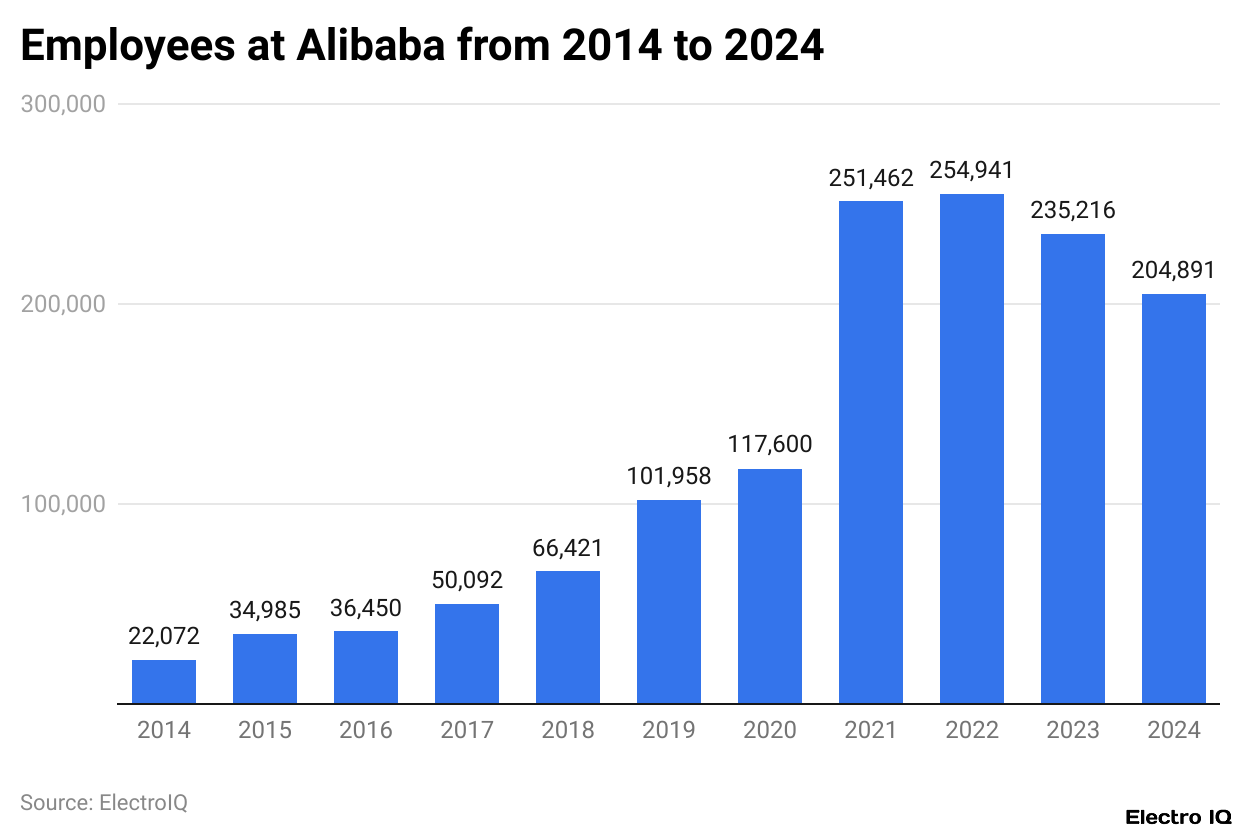
(Reference: statista.com)
- By the end of this coming March in 2024, full-time employees employed with Alibaba Group Holding Limited, the largest e-commerce company in China, were already 204,891.
- It is the second most valuable publicly-listed internet company in China and one of the largest worldwide by revenue.
- The company went public in the record-setting IPO of US$25 billion in September 2014. Today, Alibaba sells at the global level in e-commerce, retail, internet services, and fintech sectors.
- Best known for their B2-B platform Alibaba.com, it includes segments such as 1688.com and AliExpress.com, as well as its C2C marketplace Taobao, B2C retail platform Tmall, and online payment service Alipay.
- In January 2020, Alibaba employed more people than Yahoo and Facebook combined, with most employees located in China.
- By the year 2019, more than a third of its senior management was made up of women, and almost 45% of all staff members were less than 30 years old.
- In 2023, Eddie Wu, one of the co-founders of Alibaba, took over as CEO executive chairman, replacing Daniel Zhang.
- Every May 10, Alibaba will celebrate Employee Appreciation Day, where all Aliren employees would bring their family to the company campus to celebrate a day-long carnival.
Alibaba’s Annual Segment Revenue Distribution
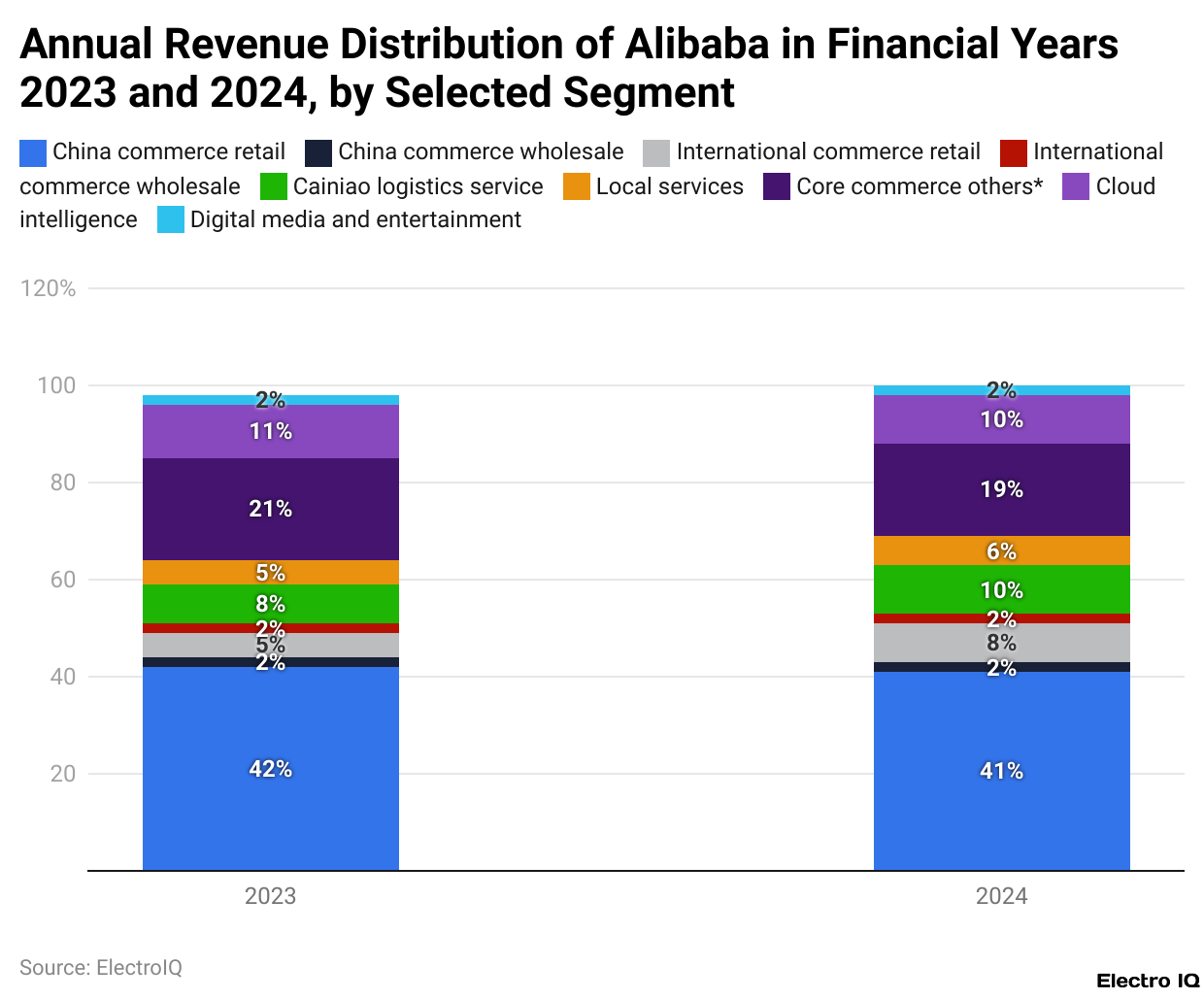
(Reference: statista.com)
- For the financial year that ended March 31, 2024, Alibaba Group – the Chinese e-commerce giant – recorded an overall annual turnover of approximately 941 billion yuan.
- The largest segment was that of domestic e-commerce retail, which accounted for 41% of the overall revenue.
- Alibaba’s domestic e-commerce platforms, including Taobao and Tmall, generated revenues exceeding 414 billion yuan, an increase of around 19 billion yuan year on year.
- Within this segment, the largest growth was in direct sales, propelled by a strong demand for consumer electronics and home appliances.
- Only 8% of total revenues were captured by international e-commerce retail. However, this segment saw excellent growth, up 60% y-o-y in 2024.
- This growth came from a combination of higher order volumes, AliExpress’s choice contribution to significant revenues, and improvements in monetization strategies.
Alibaba’s Financial Performance in Q4 2024
- Alibaba’s statistics show that a net income of RMB48,945 million (approximately US$6,705 million), which was attributable to ordinary shareholders, was reported by Alibaba.
- The company’s net income rose to RMB46,434 million (approximately US$6,361 million), which has grown remarkably by 333% year on year. This transformation was chiefly the result of increased income from operations, market-to-market changes in equity investments, and enhanced results from investees using equity methods.
- These achievements were, however, partially countered by increased impairment of investments. Non-GAAP net income for the year that ended on December 31, 2024, amounted to RMB 51,066 million (US$6,996 million), representing a 6% rise from RMB 47,951 million for the same quarter in 2023.
- Diluted earnings per ADS were RMB20.39 (US$2.79), while diluted earnings per share stood at RMB2.55 (US$0.35 or HKUS$2.75).
- Non-GAAP diluted earnings per ADS increased by 13% year-on-year to RMB21.39 (US$2.93), with non-GAAP diluted earnings per share rising to RMB2.67 (US$0.37 or HKUS$2.88), also a 13% increase.
- Net cash provided by operating activities amounted to RMB 70,915 million (US$9,715 million), or a growth of 10% compared with RMB 64,716 million for the same quarter of the previous year, 2023.
- Free cash flow, an important non-GAAP liquidity metric, has fallen by 31% to RMB 39,020 million (US$5,346 million) from RMB 56,540 million in the previous year. Increased expenditure on cloud infrastructure investments was the cause for most of this decline, partially offset by changes in other working capital.
Alibaba Traffic By Country
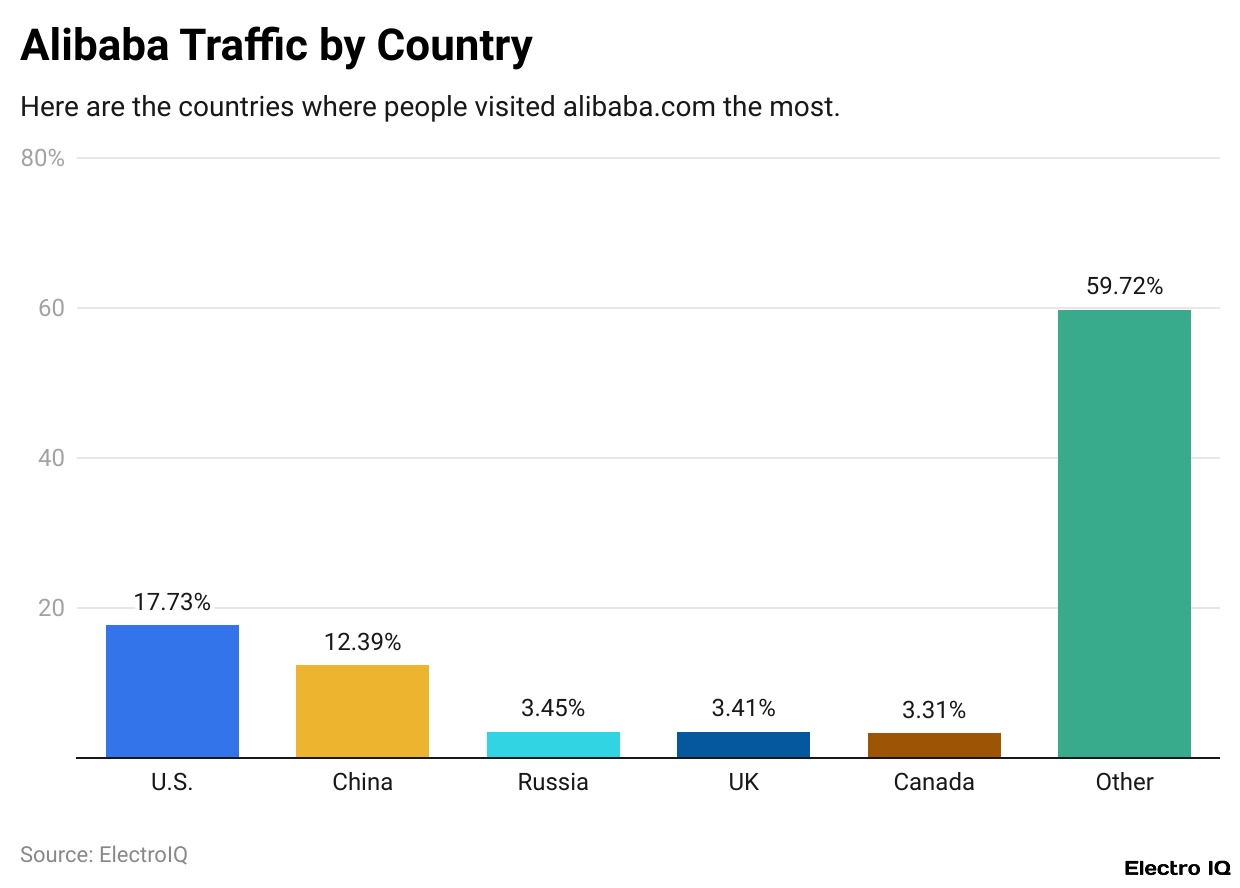
(Reference: wallstreetzen.com)
- Alibaba statistics indicate that this metric is supposed to measure the distribution across different countries. Most probably, it is about site visitations, market share, or the number of users.
- The US states are at 17 % 73, while China occupies second place at 12.39 %.
- The other three, consisting of Russia (3.45 %), the UK (3.41 %), and Canada (3.31 %), take only small amounts.
- The remaining 59.72 % will be shared among various other countries combined, showing broad distribution beyond the top five nations.
Alibaba User By Age

(Reference: wallstreetzen.com)
- Now, almost all of Alibaba’s users can be generalised as young and middle-aged persons. The largest age group using Alibaba is made up of people between 25-34 years old, which contributes 28.52% of its total users.
- It implies that young working people and millennials are the higher part of its customer base since they are adapted and understand online purchasing behavior and may afford it possibly.
- The second group consists of users aged 35-44, with a 19.95% share. These users seem to be more financially stable and likely to buy for themselves and their families.
- Close behind is the 18-24 segment, contributing 19.35% of users, which shows that young adults and college students are also shopping online, possibly for clothes, gadgets, and everyday needs. Users aged 45 to 54 account for 14.91% of Alibaba’s total users.
- Those aged 55 to 64 account for 10.76%. The figures show that middle-aged and older adults are taking to online shopping, but not at the rate young adults have done.
- The least populous group is that of 65 years and older, members of whom amount to a mere 6.51%. This suggests that it is the demographic of senior citizens that is least into even using Alibaba at all, probably due to lack of or minimally low technological know-how or preference to old-style shopping.
- Nevertheless, there’s evidence that more and more senior citizens are trying e-commerce.
Factors Influencing Alibaba’s Growth And Challenges
- From several angles, many catalysts determine Alibaba’s revenue growth. The company’s giant bets on AI, together with cutting-edge applications such as Tongyi Qianwen and cloud computing, make Alibaba an emerging markets technologies front-runner.
- Expansion into overseas markets, with particular emphasis on Europe and Southeast Asia, has widened its revenue avenue.
- Such growth has been further boosted by a phenomenal Singles’ Day in China, which saw Taobao and Tmall enjoy their highest record of buyer engagement and GMV growth. However, these growth drivers face some significant challenges.
- The slowdown in the economy in China has kept spending down and affected the performance of Alibaba’s domestic e-commerce platforms. The competition is intensifying; JD.com and Pinduoduo are quickly becoming forces in the market.
- JD.com is being able-bodied with its focus on logistics and quick deliveries while being a global competitor in cloud computing and cross-border commerce.
- Alibaba statistics state that as Alibaba undertakes a transformation of its business strategy, cutting across concepts of monopoly capitalisation and guaranteed growth, in AI, the company recently channeled US$20 million into developing AI-based applications, such as Connect, which boost digital marketing and e-commerce automation.
- In addition, Alibaba is ramping up its cloud infrastructure to keep pace with demand for AI applications, aggressively competing with Amazon Web Services and Microsoft Azure.
- Other entries in its global expansion schematic include investments in Indonesia and partnerships with GoTo. In 2024, the stock price has good stamina, climbing up almost 13% in the first two weeks due to a resurgence in sentiment with respect to AI and cloud business growth.
- In contrast to this positive sentiment, the stock dipped slightly after its earnings report was released in September 2024, where revenue expectations were not quite met, making investors cautious.
Conclusion
As per Alibaba statistics, the fiscal year 2024 stood out in the transformation of Alibaba, a period characterized mainly by strategic repositioning and consolidation of core business areas. Despite several challenges in the domestic market, Alibaba’s focus on user experience and artificial intelligence gives it a strong runway for future growth. Thanks to a robust financial structure and identified strategy, Alibaba can effectively navigate through the ever-evolving global market landscape.
FAQ.
Alibaba had a total revenue for the year of 941 billion yuan (US$130.4 billion), out of which 434.9 billion yuan (US$60.2 billion) was generated by the domestic e-commerce business. Revenue for Q4 2024 was 280.2 billion yuan, mainly coming from the core commerce, cloud computing, and digital media businesses. The net income attributable to shareholders increased by 333% year-on-year to RMB48,945 million (US$6,705 million), while free cash flow went down by 31% owing to higher cloud infrastructure investments.
The main sectors generating revenues for Alibaba are numerous, with domestic e-commerce, at 41% of total revenue, being the biggest contributor. Other important sectors are international e-commerce (8%), cloud computing, digital media & entertainment, and Innovation Initiatives. In addition, the company earns from logistics, fintech, and AI solutions for business.
Alibaba’s international e-commerce segment saw 60% development in 2024, driven by increased order volumes and improved monetisation on platforms such as AliExpress and Lazada. However, this segment contributes only 8% to the total revenue. The company is narrowing down on creating a presence across the globe, especially in Southeast Asia and Europe, using strategic investments and partnerships.
Alibaba contends with an economic slowdown in China, rising competition from JD.com, Pinduoduo, and Amazon, and regulatory scrutiny at home and abroad. Other possible roadblocks include high operational costs, a slowdown in revenue growth in cloud computing, and geopolitical uncertainties surrounding the company’s global expansion. Moreover, changes in consumer behavior and increasing saturation demand that Alibaba innovates on a constant basis.
Alibaba is making significant investments in AI solutions, cloud expansion, and partnerships across the globe. This will allow the company to focus on enhancing potentially marketable AI offerings, such as Tongyi Qianwen for digital marketing and automation. This market includes expansion into Indonesia and new strategic partnerships to boost cross-border e-commerce. The Singles’ Day festival continues to be a key revenue driver, as well as increased enterprise adoption of Alibaba Cloud offerings.

Maitrayee Dey has a background in Electrical Engineering and has worked in various technical roles before transitioning to writing. Specializing in technology and Artificial Intelligence, she has served as an Academic Research Analyst and Freelance Writer, particularly focusing on education and healthcare in Australia. Maitrayee's lifelong passions for writing and painting led her to pursue a full-time writing career. She is also the creator of a cooking YouTube channel, where she shares her culinary adventures. At Smartphone Thoughts, Maitrayee brings her expertise in technology to provide in-depth smartphone reviews and app-related statistics, making complex topics easy to understand for all readers.










